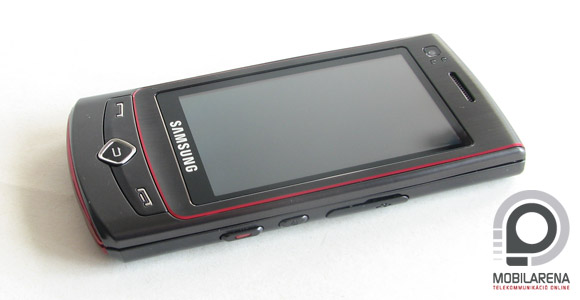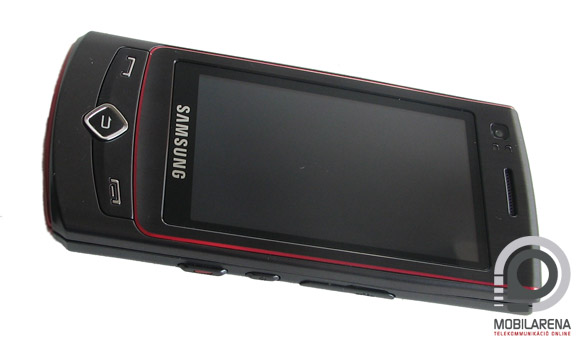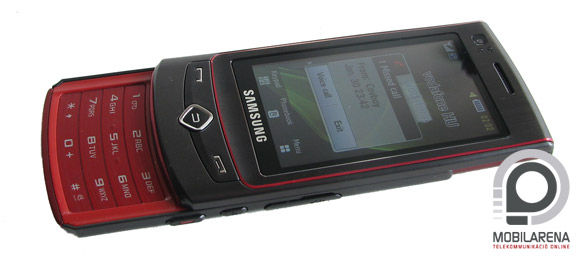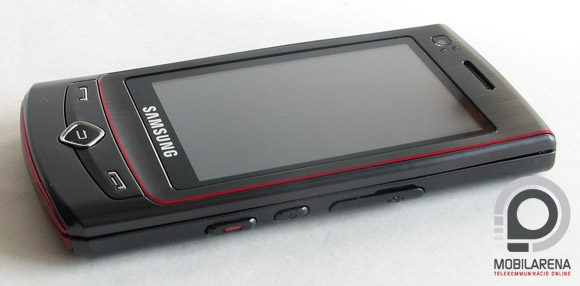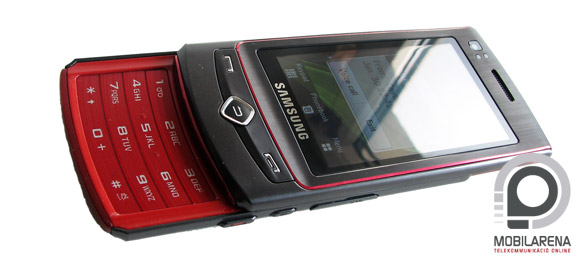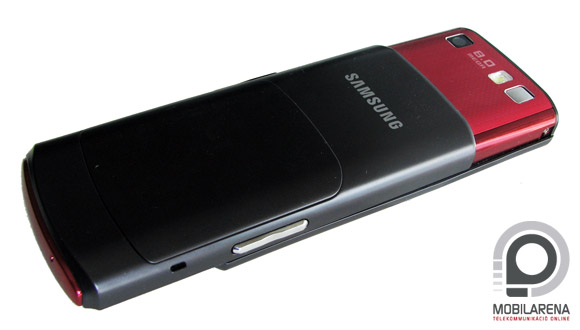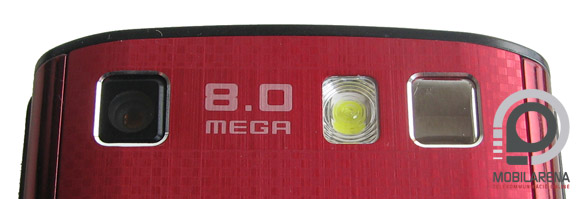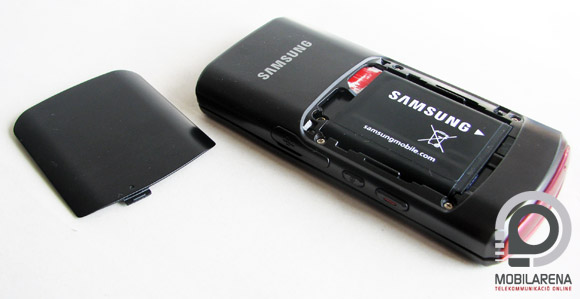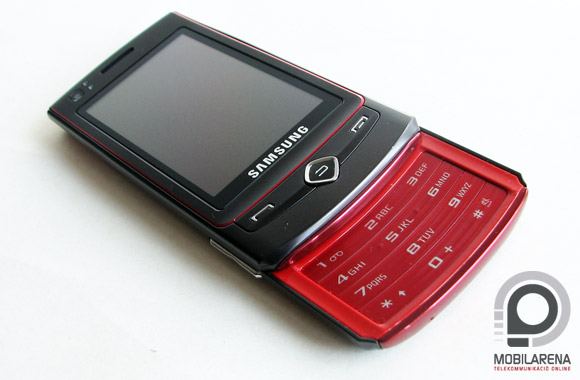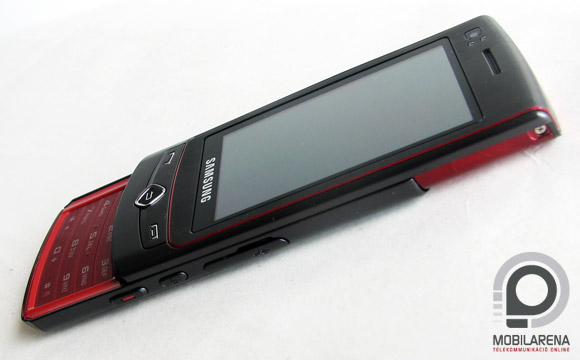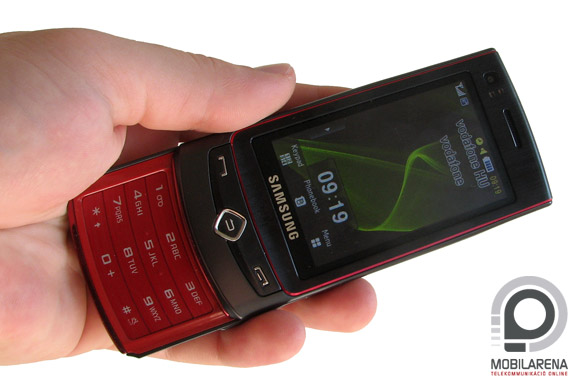Introduction
According to Samsung this year is the year of touch, at least they have announced mostly touchscreen handsets at this year’s Mobile World Congress in Barcelona. Besides Omnia HD and Beat DJ we have seen the handset called UltraTouch as well, and we already have it for review. The last time we had a handset for testing so shortly after the announcement was in the case of B&O Serenata and this means that the subject of our current review has been under development since a while ago and the handset they have display at Barcelona has practically been a near-final one.
The most problematic feature of touchscreen handsets (their real Achilles heel) is typing. A virtual keyboard can be extremely precise, it can have large buttons with a logical layout, it is still impossible to recreate a feeling of pressure point, characteristic of real keyboards. BlackBerry Storm is the first handset where we have a screen that can be pressed and it’s closer to a real keyboard’s feeling, but it’s still not perfect.
An iPhone, a Meizu, or a Prada can be tricky or cool, but I would never start writing an email on any of them. Samsung UltraTouch tries to solve this problem by having a sliding keyboard and still providing full touchscreen functionality. There has been a similar phone before, it was LG KF750, but that wasn’t a fully touchscreen device.
Exterior
The new handset came in an unmarked, unlabeled white cardboard box, which had a microUSB data cable and a cool in-ear headset inside, besides the phone of course. After getting the phone out the first problem will be taking off the back panel. And then it was clear: we have to press the little dot and push the panel upwards.
UltraTouch is very sleek. It managed to keep to the slimness of F480, in spite of the fact that it has a sliding keyboard on the bottom, even though this handset is officially the successor of U900, but I’d rather call it a kind of strange mixture. Everyone liked the metallic-red color, it’s a great match for the black plastic. Fans of AC Milan will surely like it, but it comes in blue as well, and there will be a fully black edition too. There is of course a large display on the front, it has a resolution of 240 x 400 pixels, which is usually enough, but it’s a bit low for browsing. There can be no complaints about the OLED technology, we can see the picture of UltraTouch in virtually every circumstance.
There are only three buttons below the screen, those on the sides are for handling calls, the center one is the back key. On top of the front there is a secondary camera with a light sensor. On the sides there are quite a lot of buttons, the volume control shines in silver on the left, while on the right there are the keys for the camera and unlocking the keypad. Above them there is the lid of the microUSB connector.
The slide opens smoothly when the numeric keys appear. Here we can see only those twelve buttons that are absolutely necessary and although the touchscreen has been highly improved there should have put there at least a two-way control if there is a keypad. I have already mentioned the back, but if we slide the phone open we get to see the 8 megapixel camera with a flash and a mirror.
Until now it could all seem like a dream or a fairy tale, although there are problems. The memory card (with SDHC support) can be changed only after taking the battery out, which is quite an amateur flaw from Samsung. My other issue was with the quality of materials used. Parci and Bocha have also noted that the cover doesn’t fit perfectly, but the manufacturer told us that this is true only for these test models, the ones that get in stores won’t be like this. Still, the phone is very plastic, only the part around the display is made of metal.
Hirdetés
Menu, usability
I have personally had great expectations of the new TouchWIZ user interface. There are no logical problems with it, there are tons of new widgets available, finally the main screen can be scrolled vertically as well, so we can put lots of widgets there, we should just keep in mind where did we place them. When pulling the screen to the side we get to the menu, everything has some small animation, which finally doesn’t lag. If we pull our finger to the other direction we get to the contact list with pictures.
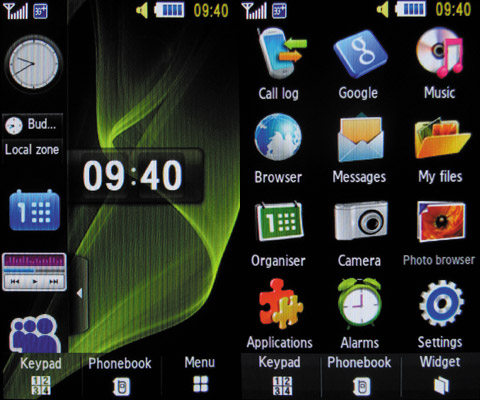
The main menu has 12 icons. There’s no use looking for the contact list over here, that’s on the bottom in the center, so we could say that we have 13 ways to go to from here. Customizability is quite poor, we can’t change the icons, or the wallpaper behind the menu, there are no themes. The order of menu items cannot be changed, we can’t switch from grid to list view, but we can choose from three fonts.
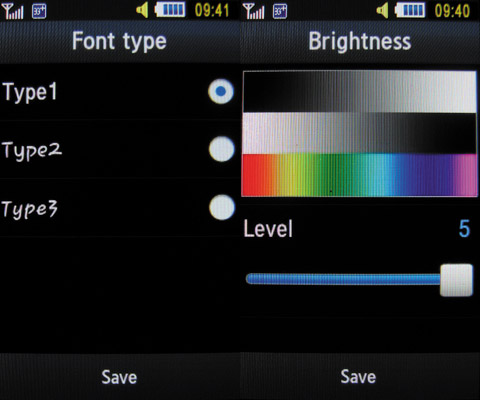
The in-call screen looks quite cool and the most important features (contact list, handsfree) are just a click away (except the voice recorder), and the system even allows us to send an SMS during a call. The light sensor above the secondary camera sees if we put the handset to our ear and turns the backlight off and the “keypad” lock on.
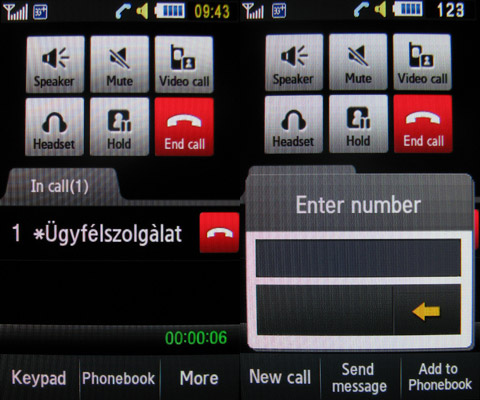
Scrolling, however, is still problematic. It’s not even close to an iPhone, a Meizu or a HTC, it’s stuttering and you never know if you’ve scrolled enough. It’s not such a big deal when getting around the contact list, as the numeric keys can be used for searching. But when browsing the web, or reading messages this algorithm proves to be a very basic one. Of course if you’ve never seen anything better than it does the job, but the best deal would have been to put a real scrolling wheel on the phone.
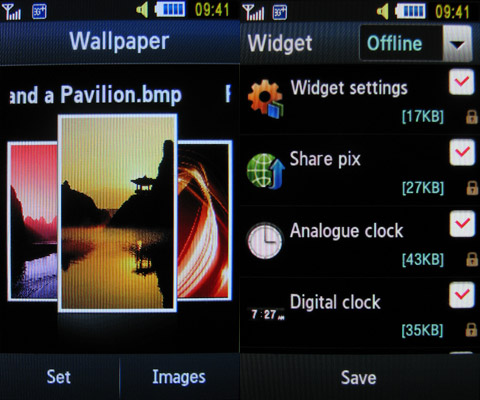
Basic functions
The contact list can store 2,000 contacts. It is quite interesting in terms of additional data, we can store a couple of phone numbers, email address, ringtone, photo, birth date and note, and there is a new feature, we can select different rhythms of vibrating alert for contacts. This doesn’t have any real point as when the phone is in my pocket I won’t feel anything specific, the only ones that could have any chance would be the member of a percussion group. Besides this we can set a number for video calling, message tone, home and work address, occupation, company, and a personal and company web page.
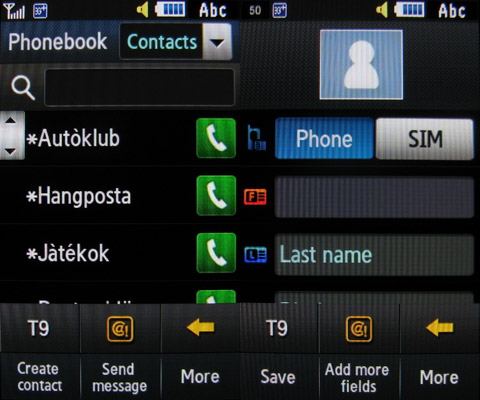
If we open up the contact list while the phone is closed than we get a virtual keyboard. As this has the same layout as the physical keyboard, I say we should use this latter one. Fortunately the handset won’t dial on first touch in the contact list, but we can open up the entry with a double-tap and here we can choose between a simple voice call, video call or sending a message.
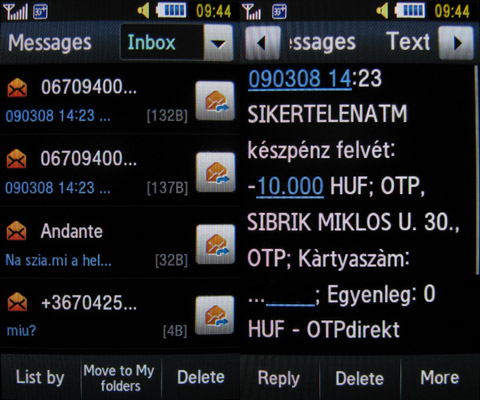
As for messaging we have SMS, MMS and an e-mail client. I have already mentioned scrolling, but typing is another thing. The method we’ve seen at the phonebook is available here as well, we get a virtual keyboard by default, and if we open the phone we have the real keyboard. The handset, however, has a gyroscope as well, so I’ve though that the virtual keyboard will turn to become QWERTY keyboard and it will be much easier to type. Well I wasn’t right, the designers at Samsung have forgotten this, so there’s no easy virtual typing.
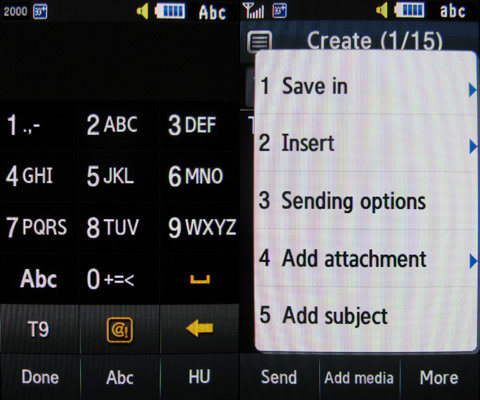
The phone can store 500 text messages, while MMS messages are stored on the internal memory, just like the emails. There is a wizard to help us set up our email account, it has presets for the network operator settings, but we can create a new account as well. The app had no problem with attachments, it was willing to send the eight megapixel photos as well. The file format doesn’t matter, the system handles those too that aren’t supported by the phone.
Camera
The camera has a resolution of eight megapixels. That’s a lot. It has a LED flash, there is no Xenon unfortunately, but we have a small mirror. We have to keep the phone horizontally when taking pictures and of course it has to be opened, otherwise we could take some nice black pictures of the phone’s back (even though the software won’t allow it). The button on the side is used for focusing and taking the picture, it’s a bit slow and somehow the phone we tested had no sounds either.
There is an impressive amount of functions, we can set the ISO value, we have preset modes, a wide dynamics range, image stabilizer, lots of resolutions, macro mode and blink detection as well. This last one is used for detecting faces on the picture and to observe if everyone has his/her eye opened. If they do, then it takes the picture and we shouldn’t have any “sleepy” subjects anymore. This could be combined with the smile detector, but usually our eyes get smaller when smiling and the software would detect that as blinking, so this has not been implemented.
When checking out the test pictures above it becomes quite evident that the number of pixels and the lots of pictures are not enough, and in fact we shouldn’t expect a better quality from such a slim phone. It’s interesting on the pictures taken with flash that stripes appear on them, but according to Samsung this problem won’t appear on the final handset. Nothing has come close to the leader Innov8, although the runner-up Nokia N86 might do something. UltraTouch, however, won’t. Probably the simple user won’t be interested in this, they just see that wow, it has eight megapixels, yours has only five and they go and buy it.
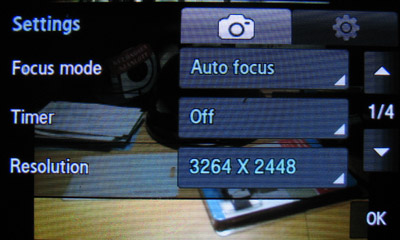
The gadget can record videos at 720 x 480 pixels, but we can choose other resolutions like VGA, QVGA and QCIF as well, of course our test video has been recorded at the highest possible resolution. The only problem is that the automatic white balance has been set so badly that everything became extra bright, but this will also be corrected on the final handset. Playback, however, was okay, movies at similar resolutions ran without a problem, DivX is supported, but I had some problems with pictures.
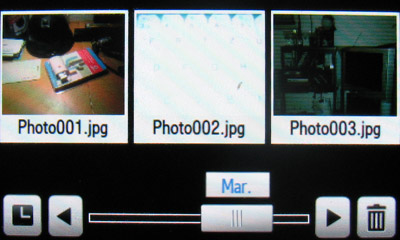
I have already hated this horizontal picture flow in Pixon, it starts running when the phone is tilted and now I have it again. You keep the handset horizontally, the pictures are loaded, you tilt the phone a bit in a direction and the software skips like 30 images and you can start playing around until you get the picture you want. And this is when the waiting game starts. It zooms in on the thumbnail, which is as pixilated as Test Drive 1 on a CGA monitor, and then we wait, and wait, and wait and then the photo becomes clear. Okay, I know that there are 8 megapixels to load, which means a minimum of 2 MB file size that has to be processed, but they might have matched the functions better and pack some more powerful hardware if they already have such a high-res camera. Fortunately we can access the pictures from the file manager as well, which is not that spectacular, but at least it’s usable.
Music
The handset is quite well prepared in terms of music, it has lots of small things to complete the set of musical features. First we have a great, in-ear headset that can be taken apart, it’s a really high-quality piece, but since it can be taken apart we can use any kind of headset we want. Sound quality through the handsfree speaker is also quite good, which is an exceptional thing from a handset made mostly of plastic.
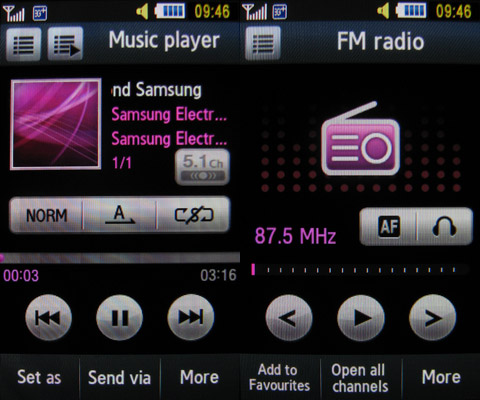
The music player sorts our tracks by ID3 tags, just as usual. If we start playback and then exit to the main screen then playback continues as usual, but the player’s widget is displayed and we can control it from there. We can stop, start and skip tracks, while volume can be set with the buttons on the side. There is, however, no equalizer, which I did not understand, as due to the special headset one would expect the phone to have all known features, still, this is not such a serious, but annoying issue.
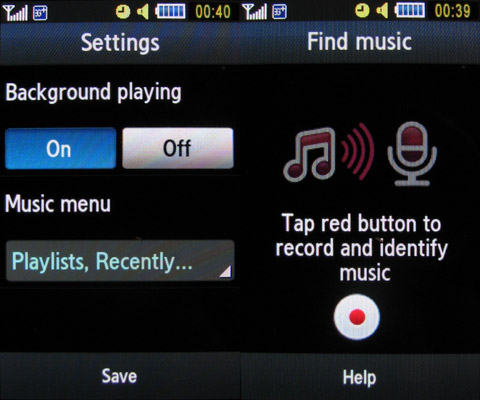
Besides the MP3 player there are two other applications that belong to the music section. The more important is the FM radio that supports RDS, it fills out the whole screen and there are large buttons for tuning. This can also run in the background and it also gets its own widget on the main screen. Of course we have to connect a headset to make it work. The other app is called „Find music”, which uses a sample recorded from the radio or with the sound recorder, uploads it to the internet and with the help of a database it tries to guess the music’s title and artist. It’s quite sensitive, it was no use that I sung a song, it gave no results, which is also a hint for you about how do I sing.
PIM and others
The calendar looks quite cool, it’s large and very logical. Entries have no type, but we have lots of fields to define anything we want, for example we can set the duration of repeats. The great advantage of the longish display is that in week view we can see the days from 9-16 o’clock without scrolling. The world clock is really spectacular as well, we see the whole world map and we can get around with our finger, while the software intelligently shows the time zones.
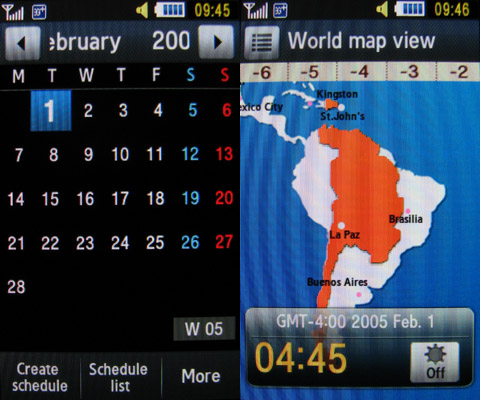
Amongst the apps we can find a calculator, a currency converter, a notebook and an RSS reader as well. We have a video editor (for what?), picture sharing which supports Facebook, Picasa, Flickr and MySpace, we just have to enter our credentials and we can instantly upload our photos from the phone, which is cool. The phone supports MS Office and PDF files as well, thanks to Picsel Viewer.
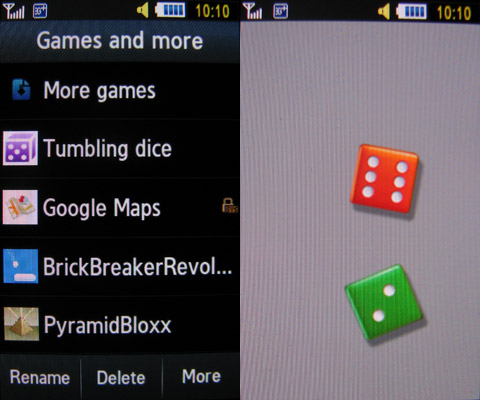
There is a completely useless, shake-controlled dice game, and two demos, PyramidBloxx (this is really great) and a wall breaker. It’s great that we have Google Maps as well (v 2.3.2), which relies on cell info if it has no contact with the satellites and as soon as it can connect it locates us with great precision. Yes, there is a built-in GPS receiver, but we have no route planning software by default, which is no wonder, as we could only use something written in Java, and Garming XT has still not been launched for this platform.
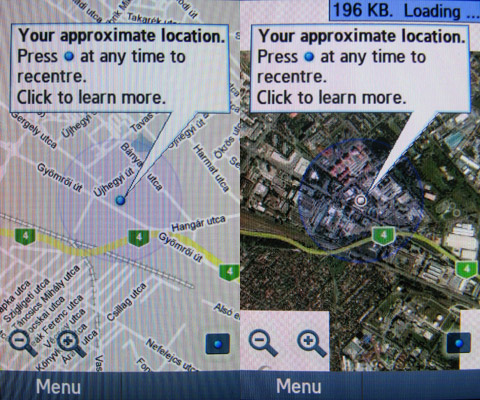
Data transfer, battery
Although it’s cool that the device supports 7.2 Mbit/s HSDPA, it has Bluetooth and microUSB, but I’ve been missing WLAN a lot for a while. Until I have launched the browser, which is Access Netfront and it’s one of the worst (I’ve been thinking what to write here that’s not vulgar) applications that I’ve seen on a handset with such a display of such dimensions.
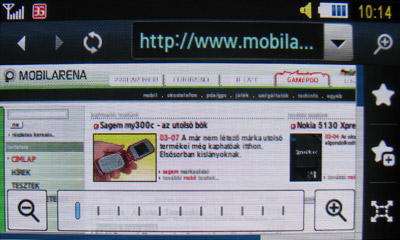
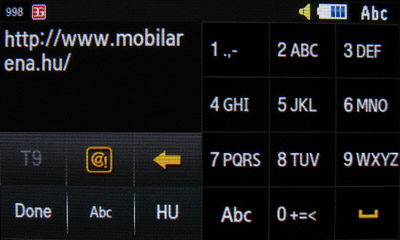
First, it has only landscape view. This would be okay, we can see the web pages better, but it’s hard to do wonders on 240 x 400 pixels (hey, it’s interesting that Nokia handsets with a Minimap browser have managed to do it). We can click on the magnifying glass icon, this way we can zoom out, but the pages still won’t fit to the width. The ugliest things happen when we start typing a URL, here’s the landscape screen and than a virtual keyboard appears on the right side, but no, it’s not QWRETY, it’s just like the phone’s real keyboard. I have to repeat this, just to make things very clear: we have a landscape view. It has to be landscape, as that’s the only view supported by the app. They had to design a virtual keyboard for typing. Virtual means that the designer draws the keyboard where he would like to. And there is a lot of free space, but it seems that they didn’t even think about QWERTY. The designer chose the worst possible solution.
The battery kept the phone online for two days and I didn’t use the phone a lot. I’ve browsed the web for 10 minutes at most, I had about 30-35 minutes of talk, 5-6 SMS messages and 10-15 photos. This is not much at all, although it’s not an exceptionally short uptime in this category. As a positive thing the handset can be charger through the microUSB connector as well, we now just have to wait a couple of year until the miniUSB connectors are replaced on all devices. Don’t misunderstand me, this is not a problem of Samsung, but even more, they are a good example to be followed.
Summary
Summary? They were rushing a lot. If this would be a student project I would hand it back immediately saying that this will be just fine, but keep working on it, at least as much as you did until now. The basic concept is okay, but they should take care of the details as well. The phone would have had lots of possibilities, lots of small things are problematic, those that are not revealed by the specs.
The Korean companies have a habit of not talking about each other. Samsung won’t comment on the results of LG and vice versa. This probably has some cultural roots, but now they should put the customs aside and have a look at LG and check out a Prada II. Just as LG continued Prada I, that’s how F480 and U900 should have been improved.
This path is not good. I don’t say that it’s absolutely bad, as they will have lots of sales. 8 megapixel camera, HSDPA, Bluetooth, expandable memory and a touchscreen, this is enough for the success, even more if the design is good. But it’s no winner strategy in the long run. At first I’ve been thinking if it deserves a Cool product award. But it doesn’t. If it would have a price less than 235 euros, than it might deserve it. As far we know we will have to pay more than that for the SIM-free version, although it is possible that some carriers will like it a lot. As for me, I’m waiting for Omnia HD.
Bog
Translated by Szaszati
The handset has been provided by Samsung Hungary. Thanks.
Specifications
| Samsung S8300 UltraTouch | ||
 | General | |
| Technology | GSM, UMTS, HSDPA | |
| Size | 110 x 51.5 x 12.7 mm | |
| Weight | 110 grams | |
| Colors | Black, red, blue | |
| Display | ||
| Display size | 2.8” diagonal | |
| Display resolution | 240 x 400 pixels | |
| Display type | OLED, capacitive | |
| Memory | ||
| Phonebook capacity | 2000 | |
| SMS memory / max. MMS size | 500 / 300KB | |
| Internal memory | 80 MB | |
| Memory expandability | microSDHC (max 8GB) | |
| Data transfer | ||
| Frequency bands | GSM 900/1800/1900 MHz | |
| GPRS / EDGE | yes / yes | |
| UMTS / HSDPA | yes / yes- 7.2 Mbit/s | |
| IrDA / Bluetooth | no / 2.1 A2DP | |
| WiFi | no | |
| Push-to-talk / RSS | no / yes | |
| GPS receiver | yes | |
| Basic functions | ||
| Profiles | yes | |
| Vibra function | yes | |
| Built-in handsfree | yes | |
| Voice dialing / voice commands | no / no | |
| Sound recorder | yes | |
| Alarm clock | yes, also when turned off | |
| Predictive text entry | yes | |
| Software | ||
| Platform | Samsung TouchWiz | |
| WAP / HTML browser | yes / yes - Access Netfront | |
| E-mail client | yes | |
| Java | yes | |
| Games | 2 demos + dice roller | |
| Currency converter | yes | |
| Extra software | Picsel Viewer, Google Maps, Music Find, SharePix | |
| Multimedia | ||
| Main camera | 8 megapixels, autofocus, flash, blink detection | |
| Secondary camera | yes | |
| Video recording | 720x480 pixels | |
| Music player | yes, can run in background | |
| Equalizer | no | |
| FM radio | yes, RDS | |
| Battery | ||
| Main battery | 880 mAh Li-Ion | |
| Standby time | 350 hours | |
| Talk time | 4 hours | |
| Other | ||
| touchscreen display, widgets, motion sensor | ||
